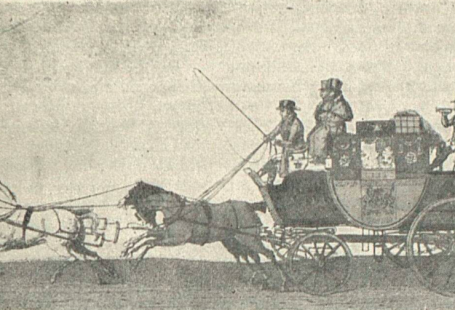‘Sea shanties are having a great vogue right now,’ reports the Leeds Mercury in January 1927. The writer may well have been describing the sea shanty trend of the present day, as the haunting harmonies of traditional sea shanties once again have captured the popular imagination.
And one hundred years ago, during the 1920s, sea shanties were also incredibly popular. You could listen to them on the radio, or on your gramophone, and they were even performed by MPs.
Want to learn more? Register now and explore The Archive
The Dundee Courier in April 1926 advertises sea shanties to be broadcast from Aberdeen as part of ‘A Nautical Programme.’ Sung by baritone Robert Watson, and accompanied by the Aberdeen Male Voice Choir, you could expect to hear such shanties as The Liverpool Girls, Shenandoah, Haul Away Joe, and Heave Away, My Johnny.
A month later, in May 1926, the Portsmouth Evening News reports how ‘Sea shanties are to the fore in topical music just now,’ as it reviews a new sea shanty record, which promised to ‘instantly command attention from gramophone owners.’
‘Well rendered and clearly recorded,’ these shanties were performed by Robert Carr and the Seafarers’ Chorus. Including such classics as What Shall We Do With a Drunken Sailor?, Whisky Johnny and Bound for the Rio Grand, the Portsmouth Evening News labels the shanties as ‘real masterpieces of their type.’
Robert Carr and the Seafarers’ Chorus were to release another record in January 1927, available at ‘only half-a-crown.’ The Leeds Mercury gives the following description of these ‘fine sea shanties:’
‘Clear the Track, Let the Bullgine Run’ is a rousing, rollicking shanty that goes with a swing and it is well-matched by the two little ones, ‘Santa Anna’ and ‘The Hog’s-Eye Man’ that accompany it. Rather more of the ballad type, but with a distinctive appeal, are the pair on the other disc, ‘Goodbye, Fare Ye Well’ and ‘We’re All Bound to Go,’ both by R.R. Terry.
So why were sea shanties so popular in the 1920s? The answer lies somewhat in the nostalgia that was felt for a bygone era, as the days of sailing ships faded into a distant memory.
But one man, a Mr. Herbert W. Fison, a retired master mariner, was able to remember the days of sail and the sea shanties that went along with them. He was due to give a radio broadcast in January 1927 entitled ‘Talk on Sea Shanties in the ‘Sixties,’ that is, the 1860s, ‘when Sea Shanties were still in common use on board ship.’
The Portsmouth Evening News gives a summary of Mr. Fison’s talk:
In the Sixties, Mr. Fison, as a boy of 14, was an apprentice on board one of the old ocean going full rigged sailing ships, which have now almost entirely passed out of use, and he will describe something of the toils and hardships of a long ocean voyage in those days, and show how the different kinds of work on board ship had their special Shanties, and the way in which the sailors sang them.
‘Clearing Cherbourg’ | Illustrated Times | 7 August 1858
In December 1928 one Captain Alexander H. Smith was giving another talk regarding the ‘History of Sea Shanties,’ this time to the Arbroath Rotary Club. In it, he confirmed the idea that the popularity of the sea shanty lay in this nostalgia for a bygone era, as reports the Dundee Evening Telegraph:
This was no doubt the reason why it had been so little talked about until the passing of sailing ships had reminded some of them of its help and assistance in time of trouble in their young days.
Indeed, one can imagine that emerging from the most mechanised of any wars up until that point, that the romanticism of the sea shanty, with its complete freedom from modernity and the destruction it had wrought, represented a comforting escape into a world that had long since passed.
The Dundee Courier in October 1928 describes this ‘literary renaissance’ of the sea shanty, but states ‘To hear the shanty in a cozy parlour is one thing, to hear them in their true setting at sea is quite another.’ The writer goes on to invite his reader to imagine:
...a vessel rolling along in the tropics with all canvas set, or labouring in a heavy sea, beating down the Channel or North Sea, or off the Horn. The weather may be icy cold and the gale sufficiently moderated to encourage the skipper to set reef topsails and endeavour to pinch a few miles to the good by ‘head reaching.’ Water may still flow nearly knee-deep across the deck; occasionally a green sea still slops over the weather rail as the crew haul away in the grey light of a winter’s day 50 degrees to 58 degrees north or south, whilst the shanty man eerily sings:
Blow, my boys, for I long to hear you.
Blow, boys, blow!
Blow, my bully boys, blow!
The sea shanties were only sung ‘where the men had any heavy labour to do,’ rendering them perhaps a little less romantic than their whimsical melodies imply. The Dundee Courier reports how there were a variety of different shanties, ranging from ‘capstan shanties, pump shanties, hauling and running shanties.’
Sailors singing sea shanties as they haul on the ropes | The Bystander | 30 July 1930
A ‘famous pump shanty‘ ran as follows:
Fire in the galley, and fire down below,
Leave her, Johnny, leave her,
There’s fire in the galley and fire down below,
And it’s time for us to leave her.
The shanty would end with the command ‘Belay.’
And before the popularity of the shanty faded, MPs Sir James Sexton and Mr. Ben Tillet got in on the act. The Sheffield Independent, 22 April 1931, reports how:
Sir James Sexton, M.P., is to lead the singing of sea shanties in a studio at Savoy Hill to-night. It will be broadcast between 9.45 and 10.15 in the London and Midland Regional programmes.
After a brief descriptive talk on the origin of sea shanties, Sir James, assisted by Mr. Ben Tillett, M.P., Mr. Frank Lowe and Mr. T.F. McCarthy, will sing shanties as they used to be sung on sailing ships.
Whilst we cannot say here at The Archive if history will repeat itself, with our modern day MPs singing sea shanties on the radio, what is undeniable is how these two decades of the 1920s and 2020s, separated by a century, already bear such similarities. And we can’t help but wonder, what other trends of the 1920s will we see repeated in the near future?
So why not take a sneak peak here in The Archive, and take a guess at what 1920s trends will return?











